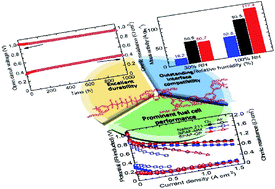Proton exchange membranes containing densely sulfonated quinquephenylene groups for high performance and durable fuel cells†
Abstract
For proton exchange membrane fuel cell applications, poly(arylene perfluoroalkylene)-based ionomers containing densely sulfonated quinquephenylene groups in the main chain (SPAF–QP) are synthesized. The combination of highly hydrophobic perfluoroalkylene and highly hydrophilic sulfonated quinquephenylene units is designed to achieve high proton conductivity with reasonable ion exchange capacity (IEC) values (1.83–1.97 meq g−1). Compared with our previous SPAF–MM membrane with fewer sulfonated hydrophilic groups, SPAF–QP membranes exhibit significant improvement in the proton conductivity, especially at low humidity (up to 6.9 mS cm−1 at 80 °C and 20% RH). The selected SPAF–QP (1 : 0.22) membrane exhibits much better fuel cell performance than the SPAF–MM membrane and comparable performance to the Nafion NRE 211 membrane even under low humidified conditions. The SPAF–QP cell also shows comparable mass activity of the Pt catalyst with that of the Nafion NRE 211 cell. During the open circuit voltage (OCV) hold test, the SPAF–QP cell retains high OCV over 0.95 V for 1000 h with a small average decay of 50 μV h−1. Post-test analyses reveal that the SPAF–QP cell retains its initial fuel cell performance with negligible changes of the molecular structure of the membrane. These properties of the SPAF–QP membrane seem highly promising for practical fuel cell applications.



 Please wait while we load your content...
Please wait while we load your content...